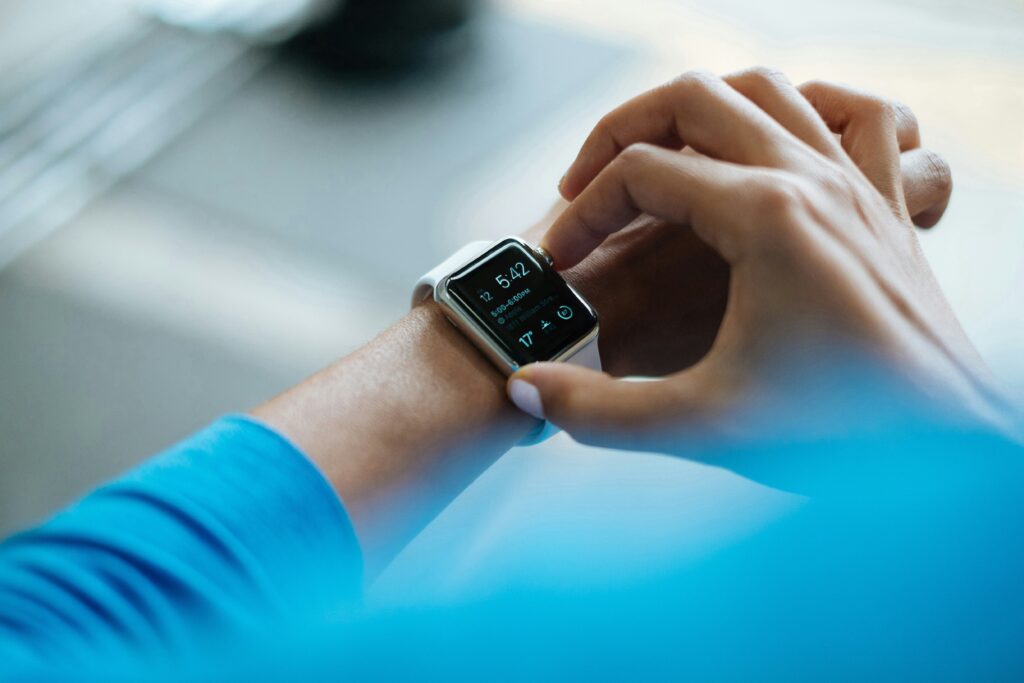News Team member Merom Arthur discusses the newest non-addictive innovation in pain management, its limitations, and the progress made in improving pain relief methods and awareness for patients.
Eating Before Exercise: Insights from Wearable Tech
Exploring how the timing of meals affects workout performance, backed by wearable tech data.
By Nolan Shah
The emergence of consumer health devices and apps has empowered people with access to their own biometric health data. Health wearables have found their way onto the bodies of almost 1 in 3 Americans, with wellness in mind. Wearables such as Whoop and Nix Biosensors, sported by Kansas City Chiefs quarterback Patrick Mahomes and professional golfer Rory McIlroy, measure sleep needs and recovery scores and even inform users of their minute-by-minute hydration status. Similarly, continuous glucose monitors constantly track blood glucose and provide users with alerts and insights about their metabolic health.
These devices, which were first developed in 1999, were intended for the use of diabetics, Today, the user population has expanded to those looking to improve all aspects of their mental and physical performance while simultaneously preventing diabetes from ever occurring. Continuous glucose monitors have also been instrumental in allowing researchers to analyze the blood glucose levels of study participants in real time, offering those with anecdotal experience the chance to confirm their experiences with scientific-grade data.

Challenges in data accuracy and adoption
Traditional academic and research institutions have been slow to adopt data collection methods using consumer wearables, citing low accuracy and validity. Nonetheless, private companies such as Supersapiens, maker of a consumer continuous-glucose monitor, are taking advantage of access to millions of user data points by conducting their own research studies.
One such study, published in July 2023 in the European Journal of Sport Science, reveals that eating between 23 and 90 minutes before exercising can lead to unfavorably low blood glucose levels in some individuals. This low blood glucose, termed reactive hypoglycemia, can cause dizziness, nausea, and even blurred vision. Yet you would need to go back to 1979 to find a study supporting the notion that low blood glucose can negatively impact performance.
“Reactive hypoglycemia is something that is well-known in the endurance sports community,” said Andrea Zignoli, a fellow and researcher at the University of Trento and first author of the paper. “In the literature what is missing is whether reactive hypoglycemia is relevant for everyone, if it is something that is just temporary, or if the same individual can be affected by the condition again and again.”
The study dataset included 6,761 users self-reporting 48,799 instances where they ate food before exercising. Researchers looked for evidence of low blood glucose, characterized by 70mg/dL, within the first 30 minutes of activity. While exploring the data, Zignoli and colleagues searched for patterns that supported hypoglycemia as a result of eating food in the ~30-90-minute pre-exercise window.
Supersapiens’ target market is endurance athletes wanting to optimize their glucose control for better performance. According to Zignoli, however, the product has found other use cases such as in diabetic populations and most recently the layman. Therefore, the study’s findings are representative of a population that consists of both endurance athletes and everyday gym goers.
Reactive hypoglycemia: A contested phenomenon
Still, experts in the metabolic health space are reluctant to give reactive hypoglycemia any merit in its relation to decreased exercise performance, especially when the supporting data comes from consumer technology.
“If reactive hypoglycemia is a problem, it can easily be avoided,” said Mikael Flockhart, postdoctoral researcher at Umea University in Sweden. “Also, glucose measured with CGM devices is not the same as blood glucose, as there is a delay factor to account for.”
Flockhart cites a key difference between clinical grade and consumer health devices. Monitors such as Supersapiens measure interstitial fluid glucose while medical continuous glucose monitors measure blood glucose. Though both metrics are accurate, interstitial fluid glucose levels are less representative of an individual’s glycemic state compared to blood glucose.
The literature remains unclear, both in the relationship between hypoglycemia and exercise, and whether consumer CGMs yield reliable and accurate data. But with advice on when to eat ranging from “Don’t eat two hours before your workout” to “Eat lots of carbohydrates 30 minutes before exercising,” the study’s finding that 8 in 100 people have a predisposition for hypoglycemia based on pre-exercise food timing is still significant.
For CGM companies like Supersapiens, with access to millions of metabolic health data points, future research will play an important role in elevating sports performance. For instance, the format of soccer games in which two periods of activity are split by halftime, lends itself to the potential for athletes suffering from reactive hypoglycemia. The same goes for American football and basketball.
As the wearables market expands, healthcare systems and researchers may have no choice but to adopt consumer health technologies, as chronic disease is responsible for lowering life expectancy and costing the U.S. $3.7 trillion per year. Chronic disease prevention requires a holistic approach, creating a demand for devices capable of measuring the effects of lifestyle behaviors on both physical and mental well-being. Spending on prevention is growing, and research leveraging wearables and apps will be important in continuing to justify the investment.
